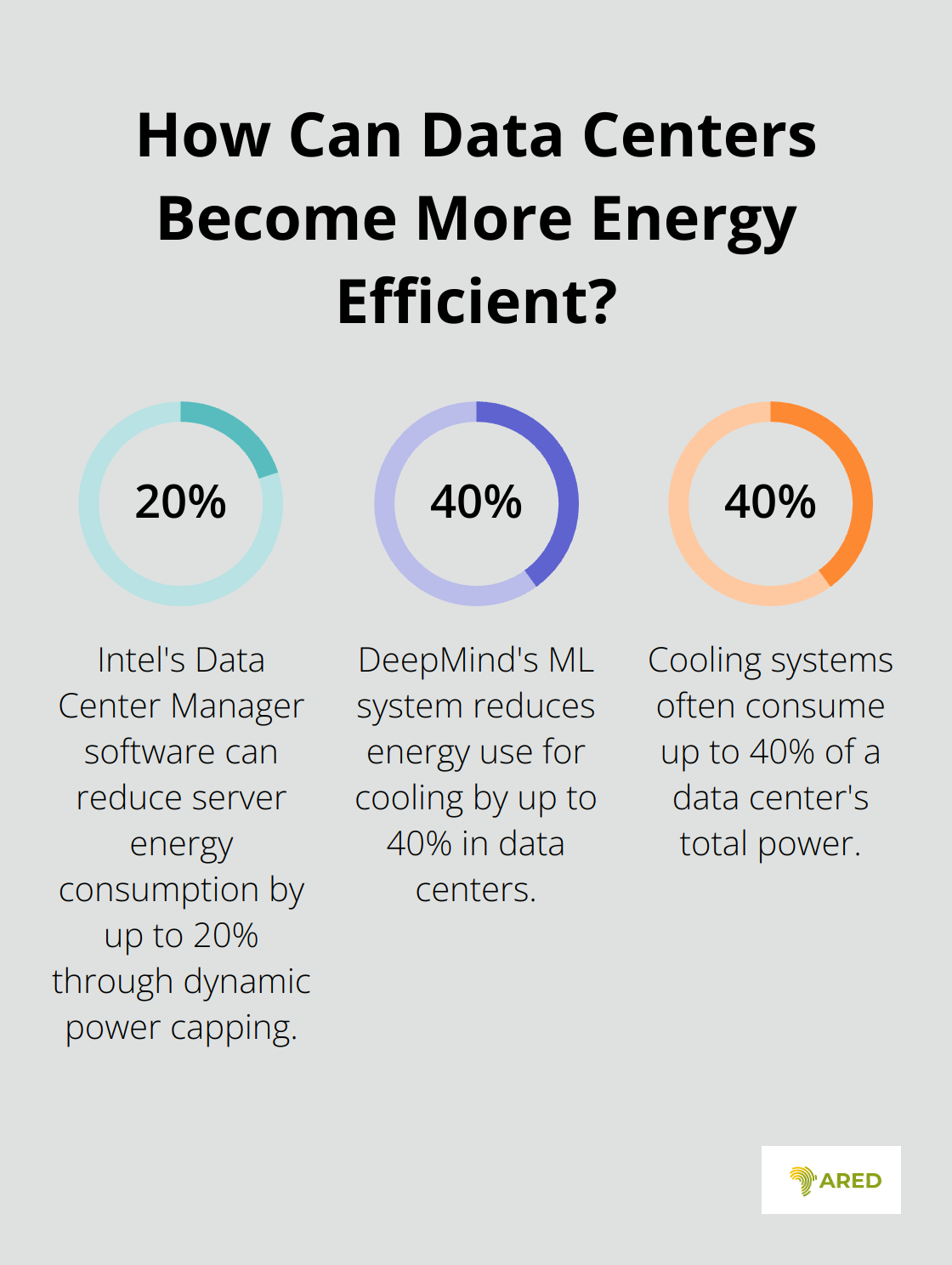
Climate-Friendly Data Centers [Pro Tips]
Data centers are the backbone of our digital world, but their environmental impact is staggering. At Shirikihub, we’re committed to exploring sustainable solutions for this pressing issue.
In this post, we’ll dive into the world of climate-friendly data centers, examining innovative technologies and best practices that are reshaping the industry. From renewable energy sources to circular economy principles, we’ll uncover the strategies that are paving the way for a greener future in data management.
The Hidden Cost of Digital Progress
The digital revolution has transformed our world, but it comes at a steep environmental price. Traditional data centers, the powerhouses behind our online activities, are major contributors to global energy consumption and carbon emissions.
Energy Hunger of Data Centers
Data centers are voracious energy consumers. According to recent studies, these digital hubs account for 1-1.3% of global final electricity demand. In 2022, data centers worldwide consumed between 240-340 Terawatt hours of electricity. This massive energy appetite not only strains power grids but also contributes significantly to greenhouse gas emissions.
Carbon Footprint: The Invisible Polluter
The carbon footprint of data centers is equally alarming. These facilities are responsible for approximately 1% of energy-related greenhouse gas emissions globally. While this percentage might seem small, it translates to millions of tons of CO2 released into the atmosphere annually.

A single data center can emit as much carbon as a small town. For instance, a typical 15-megawatt data center produces about 130,000 metric tons of CO2 per year. This is equivalent to the annual emissions of over 28,000 cars.
The Growing E-Waste Crisis
Beyond energy consumption and carbon emissions, data centers are significant contributors to the global e-waste problem. The world generates a staggering amount of electronic waste, with projections suggesting that global e-waste will reach 74 Mt by 2030, almost double the 2014 figure. This increase is fueled by higher electric and electronic (EEE) consumption.
Data centers, with their constant need for upgrades and replacements, are a major source of this e-waste. Servers, storage devices, and networking equipment often have short lifespans, leading to frequent disposal. This not only wastes valuable resources but also poses serious environmental risks when not properly managed.
The environmental impact of traditional data centers is clear and urgent. As we continue to rely more heavily on digital infrastructure, finding sustainable solutions is not just an option – it’s a necessity. In the next section, we’ll explore innovative approaches and technologies that are helping to create more climate-friendly data centers.
How Are Data Centers Going Green?
The environmental impact of traditional data centers is undeniable, but the industry is not standing still. Innovative technologies are reshaping the landscape, paving the way for more sustainable and efficient operations. Let’s explore some of the cutting-edge solutions that are making data centers greener.
Harnessing the Power of Renewables
One of the most significant shifts in data center sustainability is the move towards renewable energy sources. Tech giants like Google and Microsoft are leading the charge, with ambitious goals to power their operations entirely with clean energy. Google, for instance, achieved 100% renewable energy for all its operations in 2017 and aims to run on carbon-free energy 24/7 by 2030.

Solar and wind power are at the forefront of this renewable revolution. Large-scale solar farms and wind turbines are increasingly being integrated into data center operations. For example, Facebook’s data center in Prineville, Oregon, is partially powered by a 437,000-square-foot solar farm, showcasing the potential of on-site renewable energy generation.
Hydroelectric power is another promising option, especially for data centers located near suitable water sources. Microsoft’s Project Natick, an underwater data center off the coast of Scotland, not only uses seawater for cooling but also harnesses tidal energy for power, demonstrating innovative approaches to sustainable energy sourcing.
Cooling Innovation: Less Energy, More Efficiency
Cooling systems are one of the biggest energy drains in data centers, often consuming up to 40% of a facility’s total power. However, new cooling technologies are dramatically reducing this energy burden.
Liquid cooling is emerging as a game-changer. By directly cooling servers with a liquid coolant, these systems can be up to 3,000 times more efficient than air cooling. Companies like Iceotope are pioneering precision liquid cooling technologies that not only reduce energy consumption but also allow for higher density server configurations.
Free cooling, which uses naturally cool air or water to regulate temperature, is another innovative approach. Google’s data center in Hamina, Finland, uses seawater from the Gulf of Finland for cooling, eliminating the need for energy-intensive chillers and reducing cooling energy use by 80%.
Smart Power Management: AI to the Rescue
Advanced power management techniques are revolutionizing how data centers consume and distribute energy. Artificial Intelligence (AI) and Machine Learning (ML) are at the forefront of these innovations.
DeepMind, Google’s AI company, has developed an ML system that optimizes data center cooling, reducing energy use for cooling by up to 40%. This system predicts future cooling needs based on various factors, adjusting cooling equipment in real-time for maximum efficiency.
Power Usage Effectiveness (PUE) is a critical metric for data center efficiency. Studies show a wide range of PUE values for data centers, but the overall average tends to be around 1.8. Data centers focusing on efficiency typically achieve lower PUE values.
Dynamic power capping is another innovative technique. This approach allows data centers to set power limits on servers based on workload demands, preventing energy waste during low-usage periods. Intel’s Data Center Manager software, for instance, can reduce server energy consumption by up to 20% through dynamic power capping.
These technologies are not just theoretical concepts but are being implemented in data centers worldwide, driving significant improvements in energy efficiency and environmental sustainability. As the industry continues to innovate, we can expect even more groundbreaking solutions to emerge, further reducing the environmental footprint of our digital infrastructure.
How to Optimize Data Center Sustainability
Sustainable data center operations go beyond just implementing new technologies. They require a holistic approach that considers every aspect of data center management. Here are some best practices that leading data centers are adopting to minimize their environmental impact.
Embracing the Circular Economy
The circular economy concept is gaining traction in data center operations. This approach focuses on extending the life of equipment, reducing waste, and maximizing resource efficiency.

One effective strategy is to implement a comprehensive asset management system. This allows data centers to track the lifecycle of each piece of equipment, from procurement to disposal. By doing so, they can identify opportunities for repair, refurbishment, or repurposing, rather than defaulting to replacement.
For instance, Meta has determined that it can now use most of its servers and network devices for five years, up from 4 years as of year-end 2021. This change has resulted in significant reductions in e-waste and resource consumption.
When equipment does reach the end of its useful life, responsible recycling is crucial. Many data centers are partnering with specialized e-waste recycling firms to ensure that valuable materials are recovered and harmful substances are properly disposed of. According to the Global E-waste Monitor 2020, only 17.4% of e-waste is formally collected and recycled. Data centers have an opportunity to significantly improve this figure.
Maximizing Server Efficiency
Server utilization is a key factor in data center efficiency. Many servers in traditional data centers operate at just 12-18% of their capacity, wasting energy and resources. Improving this metric can lead to substantial energy savings and reduced environmental impact.
Virtualization is a powerful tool for increasing server utilization. By running multiple virtual servers on a single physical machine, data centers can dramatically improve efficiency. VMware reports that their virtualization solutions can reduce server count by up to 80% and energy costs by up to 80%.
Another effective strategy is to implement workload management systems. These tools analyze server usage patterns and distribute tasks optimally across available resources. Google, for example, uses a cluster management system called Borg, which has helped them achieve server utilization rates of 25-35%, significantly higher than industry averages.
Regular audits of server usage can also reveal opportunities for improvement. Many data centers discover “zombie servers” – machines that are powered on but not performing any useful work. Identifying and decommissioning these servers can lead to immediate energy savings.
Designing for Flexibility and Growth
The design of data centers plays a crucial role in their long-term sustainability. Modular and scalable designs are becoming increasingly popular due to their flexibility and efficiency.
Modular data centers consist of standardized, pre-fabricated units that can be easily added or removed as needs change. This approach allows for more precise capacity planning, reducing the likelihood of overbuilding and wasted resources. According to a report by Markets and Markets, the modular data center market is expected to grow from $13.07 billion in 2017 to $46.50 billion by 2022, reflecting the increasing adoption of this flexible approach.
Scalable designs also allow for the incorporation of new, more efficient technologies as they become available. This future-proofing strategy ensures that data centers can continually improve their environmental performance over time.
For example, Microsoft’s Project Natick, which involves underwater data centers, demonstrates an innovative approach to scalable and efficient design. These sealed units can be deployed quickly in coastal areas, using the surrounding seawater for cooling and potentially for power generation.
By adopting these best practices, data centers can significantly reduce their environmental footprint while improving operational efficiency. As the demand for data services continues to grow, these strategies will be crucial in ensuring a sustainable digital future.
Final Thoughts
The journey towards climate-friendly data centers is well underway, driven by urgent environmental concerns and innovative technologies. As we’ve explored, the strategies for creating sustainable digital infrastructure are diverse and rapidly evolving. From harnessing renewable energy sources to implementing cutting-edge cooling systems and embracing circular economy principles, the data center industry is making significant strides in reducing its environmental footprint.

These advancements in climate-friendly data centers play a crucial role in our global fight against climate change. By significantly reducing energy consumption and carbon emissions, sustainable data centers are helping to mitigate the environmental impact of our ever-growing digital world. The shift towards green technologies in this sector is not just beneficial for the planet; it’s also proving to be economically advantageous, driving efficiency and reducing operational costs.
Looking ahead, the future of green data center technologies is bright and full of potential. We can expect to see continued innovations in areas such as AI-driven power management, advanced liquid cooling techniques, and even more efficient server designs. The integration of edge computing and distributed cloud systems, like those offered by Shirikihub’s Shiriki Cloud, will further optimize energy use and reduce latency, contributing to a more sustainable digital ecosystem.
As we move forward, the role of sustainable, solar-powered data centers will become increasingly important, especially in emerging markets. These environmentally friendly solutions, exemplified by Shirikihub’s approach, not only reduce the carbon footprint of digital infrastructure but also help bridge the digital divide, providing essential connectivity to underserved areas.
The transition to climate-friendly data centers is not just a trend; it’s a necessary evolution of our digital infrastructure. As technology continues to advance and our reliance on digital services grows, the importance of sustainable data center practices will only increase. By embracing these green technologies and strategies, we can ensure that our digital future is not only innovative and efficient but also environmentally responsible.


